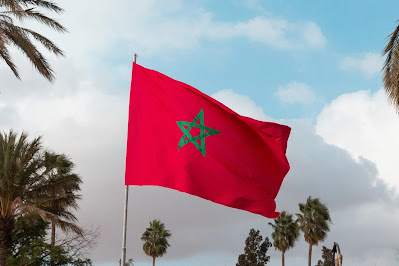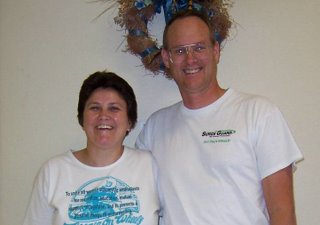 |
| Our last stop in Africa. Double click to enlarge to see what Viking has to say about this destination. |
 |
| The parking lot was full of large buses when we got to our bus but, as they left, vans filled the spaces. |
 |
| Red taxis lined the road just outside of the gates. |
 |
| Interesting building. It's hard to identify anything because Google Streetview isn't available. |
 |
| I could understand why the property across the street from Rick's Cafe had a high fence,... |
 |
| But they took it a little far to top it with broken glass bottles. Dang! |
 |
| On the left of the plaza entrance, is the Media Library |
 |
| On the right is the museum. |
 |
| As we continued on our bus tour, we saw that some of the intersections were painted in a red and white checkerboard design. |
 |
| Pictures of some of the various buildings. |
 |
| Moroccan citizens must give 2.5% of their income to the poor on top of a 39.5% tax. |
 |
| Morocco has a vibrant graffiti scene that is simultaneously international and Moroccan. |
 |
| The El Hank Lighthouse was constructed in 1916, is 167 foot tall, and has an inner spiral staircase. |
 |
| The bus slowly traveled the street parallel to the ocean. |
 |
| Pretty rocky |
 |
| The beach |
 |
| Little medal balls between road and sidewall. Can't think of a reason for them and thing they would be a trip hazard. |
 |
| I didn't see lane markings on the roundabouts. |
 |
| Funky building. |
 |
| The highest elevation of Casablanca is 377'. Many of the trees come from Australia although the Jacaranda comes from Brazil. |
 |
| Tagine is a Moroccan dish of vegetables and meat with a lot of spices. There is a spice mix of 35 spices that you can purchase to make it. |
 |
| All sorts of motorcycles and scooter ridden by everyone from teens to seniors. |
 |
| Next stop the Church of Notre Dame of Lourdes. Catholic church constructed in 1954. |
 |
| I think we mainly stopped here to use the toilets. |
 |
| In the yard is a replica of the Lourdes Holy Grotto. |
 |
| The stained-glass windows were dazzling. |
 |
| Notice this motorcycle has an insulated cover attached to the front forks. I saw many bikes with this, some even covering the hands. |
 |
| Our enthusiastic guide did a great job. She is wearing a Moroccan garment called a jalaba or jubba, which is worn by both men and women. Widows wear white. |
 |
| Parade ground outside the door is lined with Moroccan flags. |
 |
| Interesting tile work on this narrow street. |
 |
| In Morocco cats and dogs can be seen everywhere. Moroccans give them food and shelter, but they belong to no single person. |
 |
| Our guide showed us her ring. She said it symbolizes that she is part of the seventh generation in her tribe. Generations follow father. Berber girls usually have tribal tattoos on their face. |
 |
| These books were all in English. |
 |
| Our bus drove past the main entrance to the Royal Palace. |
 |
| Since its inauguration in 2012, the Casa Tramway has carried people along its 27 miles of track stopping at 70 stops. |
 |
| The centerpiece of the square is the Zevaco Dome, named after its designer Jean-François Zevaco. The globe-shaped sculpture is colloquially called Kora Ardia and was built in 1975. |
 |
| Entrance to the port. We hurriedly ate some lunch and headed back out for a small group tour with our friends. |
 |
| Our first stop was a viewpoint where we could see the mosque over the water. |
 |
| Cats, cats, everywhere. |
 |
| Looks like ice plants and agave grow well here. |
 |
| This mama dog acted like she was looking for handouts. |
 |
| These murals are of two professional footballers (soccer to me) and a team manager. |
 |
| This mural is entitled "Mother Power" |
 |
| We were dropped off along the beachfront road so we would walk up the street. |
 |
| The road overlooked the beachfront resorts, closed during their off season. |
 |
| The beach looks like more dirt than sand. |
 |
| Looks like the rocks got tagged. |
 |
| We got to enter the plaza and see the covered walkway on the right. The plaza we walked on covered the underground parking lot, which holds about 800 cars. |
 |
| Unlike most mosques, this one doesn't have a dome. |
 |
| Example of zellije, a Moroccan traditional glazed decorative tile. Each piece is hand-made and no two are alike. |
 |
| Each of these slanted enclosures holds a light so the structure can be lit at night. |
 |
| Supposedly part of the floor is built out over the sea, but I didn't see that. Some of the floor had carpet over it. |
 |
| Balcony at the back of the Prayer Hall where women can worship behind screens. |
 |
| There are 360 hidden speakers so all can hear the Imam |
 |
| The Prayer hall is simply a large hall that the men use for worship. It is a very important part of the mosque. There are no seats as Muslims worship and pray on the floor. |
 |
| Local artisans and craftsmen were employed in the construction of the mosque, preserving traditional Moroccan craftsmanship and supporting the local economy. |
 |
| There are 114 pillars and the floor is heated. The roof is made of aluminum and retracts in 3 minutes. The ceiling is 282' high. |
 |
| Our guide is standing in the middle of the king's walkway at an area where there are windows to see below. |
 |
| The ritual washing, known as wudu, takes place in the area below before worship. |
 |
| The Hassan II Mosque is equipped with a seawater cooling system that regulates the temperature inside the prayer hall, providing a comfortable environment for worshippers. |
 |
| Door at the front of the hall where the Imam enters the hall. |
 |
| Entrance hall |
 |
| The doors are made of titanium. |
 |
| We go downstairs, use the restrooms, then enter the washing area. |
 |
| Taking about independence... Morocco officially gained its independence from French rule on March 2, 1956, and from Spain on April 7 of the same year. |
 |
| What!? A Pepsi cooler? I had only seen Coke coolers. But wait, they have Mt Dew.... stop the van. Oh wait, that's not Mt Dew, they tricked me, there's only Coke products in that cooler. |
 |
| Typical small shop. |
 |
| Bye bye Morocco and Africa. |

















































No comments:
Post a Comment